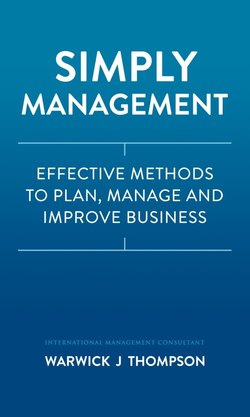Читать книгу Simply Management: Effective Methods to Plan, Manage, and Improve Businesses - Warwick J Thompson - Страница 9
На сайте Литреса книга снята с продажи.
4. BARRIERS TO ENTRY
ОглавлениеCreating or building barriers to entry – ( a cost, technology or market hurdle that a competitor must surmount just to become a competing participant in the market) – is rarely a successful strategy. Unfortunately, having low barriers to entry (e.g. low cost, short timeframe, any location, low or easily-copied technology) means it is easy for many new competitors to enter the market when they see your success. This often fragments the market so it is uneconomic for all of the participants and trading at low/prices/low profits or even losses leads to the collapse of all their businesses.
Having patents to protect a product or process can be a temporary barrier to competitive entry, but:
•Pursuing a patent is a distraction from other management activity
•Patents are time-consuming and expensive to establish
•There can be long delays before the patent is issued
•They may need to be registered in many separate countries, thus escalating cost
•They need maintenance payments to remain in place
•They are unenforceable in many developing countries
•Proliferation of copiers makes enforcement impossible
•They are published, thus giving information to potential copiers
•They have a fixed-term life
•They can be contested or ignored
•Enforcement action is hugely costly
•Constant vigilance (another expense) is required to detect infringement
•Minor changes to product or process by competitors can obviate the patent
•They create an illusion of security that can be by-passed by innovation.
It is possible to use secrecy to create a short-term barrier to entry, for example, by keeping the technology or process secret, or holding source codes to software. Eventually, either the secrecy is broken or the product/process is superceded by something better or providing a completely different solution.
It is also possible to secure exclusivity to the source of supply of a key material or input. Vertical integration by acquiring the source of supply can build a competitive barrier. Again, that is usually a short-lived barrier to entry as other supply-sources can appear.
A more effective barrier to entry is market coverage and positioning. Getting your product, process or service quickly established in the marketplace, accessing the widest possible customer base in a short timeframe, dominating the market, and getting a high or saturation level of brand recognition and brand positioning can make market entry very difficult for new competitors.
Not only does that raise a marketing barrier for new entrants but it can also create a significant cost-barrier. A new participant will have low or no volume-sales on entry, but will simultaneously incur high marketing expenses just to compete against the dominant participant. If a manufacturer, the new participant will also have very high unit costs because of no or low volume sales on entry.
Prompt market saturation in both promotion and distribution, combined with strong brand-positioning has been used as a very successful barrier to entry by the Japanese consumer-electronics industry, mobile phone manufacturers, U.S. consumer-software companies, and many others.
